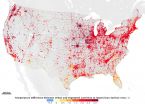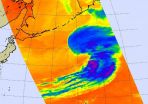(Press-News.org) Cities are well known hot spots - literally. The urban heat island effect has long been observed to raise the temperature of big cities by 1 to 3°C (1.8 to 5.4°F), a rise that is due to the presence of asphalt, concrete, buildings, and other so-called impervious surfaces disrupting the natural cooling effect provided by vegetation. According to a new NASA study that makes the first assessment of urbanization impacts for the entire continental United States, the presence of vegetation is an essential factor in limiting urban heating.
Impervious surfaces' biggest effect is causing a difference in surface temperature between an urban area and surrounding vegetation. The researchers, who used multiple satellites' observations of urban areas and their surroundings combined into a model, found that averaged over the continental United States, areas covered in part by impervious surfaces, be they downtowns, suburbs, or interstate roads, had a summer temperature 1.9°C higher than surrounding rural areas. In winter, the temperature difference was 1.5 °C higher in urban areas.
"This has nothing to do with greenhouse gas emissions. It's in addition to the greenhouse gas effect. This is the land use component only," said Lahouari Bounoua, research scientist at NASA's Goddard Space Flight Center in Greenbelt, Maryland, and lead author of the study.
The study, published this month in Environmental Research Letters, also quantifies how plants within existing urban areas, along roads, in parks and in wooded neighborhoods, for example, regulate the urban heat effect.
"Everybody thinks, 'urban heat island, things heat up.' But it's not as simple as that. The amount and type of vegetation plays a big role in how much the urbanization changes the temperature," said research scientist and co-author Kurtis Thome of Goddard.
The urban heat island effect occurs primarily during the day when urban impervious surfaces absorb more solar radiation than the surrounding vegetated areas, resulting in a few degrees temperature difference. The urban area has also lost the trees and vegetation that naturally cool the air. As a by-product of photosynthesis, leaves release water back into to the atmosphere in a process called evapotranspiration, which cools the local surface temperature the same way that sweat evaporating off a person's skin cools them off. Trees with broad leaves, like those found in many deciduous forests on the East coast, have more pores to exchange water than trees with needles, and so have more of a cooling effect.
Impervious surface and vegetation data from NASA/U.S. Geologic Survey's Landsat 7 Enhanced Thematic Mapper Plus (EMT+) sensor and NASA's Moderate Resolution Imaging Spectroradiometer (MODIS) sensors on the Terra and Aqua satellites were combined with NASA's Simple Biosphere model to recreate the interaction between vegetation, urbanization and the atmosphere at five-kilometer resolution and at half-hour time steps across the continental United States for the year 2001. The temperatures associated with urban heat islands range within a couple degrees, even within a city, with temperatures peaking in the central, often tree-free downtown and tapering out over tree-rich neighborhoods often found in the suburbs.
The northeast I-95 corridor, Baltimore-Washington, Atlanta and the I-85 corridor in the southeast, and the major cities and roads of the Midwest and West Coast show the highest urban temperatures relative to their surrounding rural areas. Smaller cities have less pronounced increases in temperature compared to the surrounding areas. In cities like Phoenix built in the desert, the urban area actually has a cooling effect because of irrigated lawns and trees that wouldn't be there without the city.
"Anywhere in the U.S. small cities generate less heat than mega-cities," said Bounoua. The reason is the effect vegetation has on keeping a lid on rising temperatures.
Bounoua and his colleagues used the model environment to simulate what the temperature would be for a city if all the impervious surfaces were replaced with vegetation. Then slowly they began reintroducing the urban impervious surfaces one percentage point at a time, to see how the temperature rose as vegetation decreased and impervious surfaces expanded.
What they found was unexpected. When the impervious surfaces were at one percent the corresponding rise in temperature was about 1.3°C. That temperature difference then held steady at about 1.3°C as impervious surfaces increased to 35 percent. As soon as the urban impervious surfaces surpassed 35 percent of the city's land area, then temperature began increasing as the area of urban surfaces increased, reaching 1.6°C warmer by 65 percent urbanization.
At the human level, a rise of 1°C can raise energy demands for air conditioning in the summer from 5 to 20 percent in the United States, according the Environmental Protection Agency. So even though 0.3°C may seem like a small difference, it still may have impact on energy use, said Bounoua, especially when urban heat island effects are exacerbated by global temperature rises due to climate change.
Understanding the tradeoffs between urban surfaces and vegetation may help city planners in the future mitigate some of the heating effects, said Thome.
"Urbanization is a good thing," said Bounoua. "It brings a lot of people together in a small area. Share the road, share the work, share the building. But we could probably do it a little bit better."
INFORMATION:
The greater a country's gender equality when it comes to employment, the higher the overall homicide rate, according to a Baylor University study of 146 countries.
"The finding does not mean that gender equality in employment increases homicide rates, but there is a correspondence," said sociologist Katie Corcoran, Ph.D. "What remains uncertain is the 'why' behind this relationship, although prior research suggests it may be due to threatening male status.
"The research findings are significant because they show that gender inequality does not only affect women," she ...
Genetic findings support observational evidence that lower vitamin D levels are associated with increased risk of multiple sclerosis, according to a new research article by Brent Richards, from McGill University, Canada, and colleagues published this week in PLOS Medicine.
Multiple sclerosis is a debilitating autoimmune disease that affects the nerves in the brain and spinal cord. There is no known cure for multiple sclerosis and it usually presents between the ages of 20 and 40 years. While some observational evidence suggests there may be a link between lower vitamin ...
A new modeling study appearing this week in PLOS Medicine supports consideration of vaccination campaigns using a single dose of cholera vaccine versus campaigns using the recommended two doses given two weeks apart.. Justin Lessler and colleagues, of Johns Hopkins Bloomberg School of Health, Baltimore, Epicentre, Paris and Médecins Sans Frontières, Geneva focus their modelling analyses on comparing the number of lives that could be saved by adopting a single vaccine dose, which could be more rapidly administered to more people than the internationally licensed ...
An oral cholera vaccine that is in short supply could treat more people and save more lives in crisis situations, if one dose were dispensed instead of the recommended two, new Johns Hopkins Bloomberg School of Public Health research suggests.
More than 1.5 billion people around the world are at risk for cholera, a severe diarrheal illness caused by bacteria linked to poor water and sanitation. It is a major killer worldwide, causing an estimated two to three million cases and 100,000 deaths each year, primarily in developing nations.
A relatively new vaccine -- internationally ...
Evolutionary theory says mutations are blind and occur randomly. But in the phenomenon of adaptive mutation, cells can peek under the blindfold, increasing their mutation rate in response to stress.
Scientists at Winship Cancer Institute, Emory University have observed that an apparent "back channel" for genetic information called retromutagenesis can encourage adaptive mutation to take place in bacteria.
The results are scheduled for publication in PLOS Genetics on Tuesday, August 25.
"This mechanism may explain how bacteria develop resistance to some types of antibiotics ...
Tropical Cyclone Atsani appeared to look more like a frontal system in infrared imagery from NASA's Aqua satellite.Early on August 26, the Joint Typhoon Warning Center issued their final bulletin on the system as it was transitioning into an extra-tropical cyclone,
The Atmospheric Infrared Sounder or AIRS instrument that also flies aboard Aqua captured infrared data on the storm on August 25 at 14:47 UTC (10:47 a.m. EDT). Cloud top temperatures in thunderstorms northeast of the center were colder than -63F/-52C, indicating high, strong thunderstorms with the potential ...
Bats are natural reservoirs of several important emerging viruses, and because cross-species transmission appears to be quite common among bats, it's important to study bats in a community context rather than concentrating on individual species.
Researchers have now used such an approach to identify characteristics of cross-species virus transmission in bats and rodents, another important viral host. The investigators uncovered evidence to suggest that viruses pass more easily between bat species than between rodent species, and they found that characteristics unique ...
In a new review of all relevant medical research on breastfeeding practices, infants 0 to 5 months of age who were predominantly, partially, or not breastfed had 1.5-, 4.8-, and 14.4-times higher risks of dying, respectively, compared with exclusively breastfed infants. Also, children aged 6 to 23 months who were not breastfed had about a 2-times higher risk of dying than children who were continued on breastfeeding.
"The findings underscore the importance of optimal breastfeeding practices during infancy and early childhood," said Dr. M. Jeeva Sankar, lead author of ...
(Boston)--Twenty-five percent of men currently taking Finasteride or Dutasteride, popularly known as Proscar and Avodart, for the treatment of benign prostate enlargement (BPH), appear not to benefit from taking these medications. Those prescribed Propecia or Avodart for male pattern hair loss (known as alopecia) are also at risk for adverse events elicited by these drugs.
These findings are part of an international, collaborative review currently online in the journal Endocrine Reviews and Metabolic Disorders. Led by Abdulmaged Traish, PhD, professor of biochemistry ...
In early August, biologist Peter Ward returned from the South Pacific with news that he encountered an old friend, one he hadn't seen in over three decades. The University of Washington professor had seen what he considers one of the world's rarest animals, a remote encounter that may become even more infrequent if illegal fishing practices continue.
The creature in question is Allonautilus scrobiculatus, a species of nautilus that Ward and a colleague had previously discovered off of Ndrova Island in Papua New Guinea. Nautiluses are small, distant cousins of squid and ...

